Blog
Biology Suggestion 2023 Class 11: Class 11 TBSE
- March 9, 2023
- Posted by: SOL Admin
- Category: Biology Suggestion 2023 Class 11
Biology Suggestion 2023 Class 11: Class 11 TBSE
Excretory Products and their Elimination
1 Marks Questions
1.In which part of nephron filtration takes
place?
Ans. Glomerulus.
2.What difference is observed in the
ascending and descending limb of Henle’s loop witch reference to permeability of water?
Ans. Ascending limp of Henle’s loop is
impermeable to water. Descending limb of Henle’s loop is permeable to water.
3.What is the PH of urine.
Ans. It is slightly acidic, PH – 6.0
4.Name the three kinds of nitrogen excretion.
Ans.(a) Ammonotelism (b) Ureotelism (c)
Uricotelism
5.What are podocytes?
Ans. Epithelial cells of Bowman’s capsule are
called podocytes.
Admission is going on for Medical and Engineering Entrance 2024
6.Besides water, name any two constituents of
human sweat.
Ans. Sodium chloride and urea.
7.What happens is glomerulonephritis?
Ans. Inflammation of glomeruli of kidney.
8.Name the excretory organ of cockroach.
Ans. Malphigian tubules.
9.Name the hormone which controls the
concentration of sodium in the body.
Ans. Aldosterene is a hormone which controls
concentration of sodium in the body.
10.Which gland secrete sebum?
Ans. The sebaceous glands are microscopic
exocrine glands in the skin that secrete an oily or waxy matter, called sebum,
11.ble to water. Name it.
Ans. Ascending limb
12.Besides water, name any two constituents
of human sweat.
Ans. Sodium chloride, Iactic acid, glucose
(any two).
13.Explian the function of vasa rectae.
Ans. It helps to retain reabsorbed ions and
urea in the interstitial fluid of the medulla, to
maintain its high osmotic pressure.
14.Name two types of nephrons found in human
kidney.
Ans. (i) Juxta medullary nephron (ii)
Cortical nephron.
15.Define GPR (Glomerular Filtration Rate)
Ans. The amount of filtrate formed by the
kidney per minute.
16.The mechanism of is also known as counter
current mechanism justify the statement.
Ans. (in the ascending limb) the out flow
runs parallel to and in the opposite direction of the inflow in the descending limb.
17.What Is maturation?
Ans. the act of passing out urine from
urinary bladder.
18.Write the function of enzyme ‘renin’
produced by kidney.
Ans. Renin is used to convert angiotensinogen
to angiotensin.
19.Name the excretory product of (i) reptiles
(ii) Prawns.
Ans.(i) Uric acid (ii) Ammonia.
Photosynthesis in Higher Plants: 1 Marks Questions
1.Expand NADP.
Ans. Nicotinamide adenine dinucleotide phosphate.
2.Name one plant that carries out photosynthesis at night?
Ans. Opuntia, chenopodium.
3.Name the cell – organelles involved in photorespiration.
Ans. Mitcohondria, chloroplast and peroxisomes.
4.Why photosynthesis important?
Ans. (a) Primary source of all food on earth.
(b) O2 is released by green plants into the atmosphere.
5.Define photosynthesis?
Ans. Photosynthesis is an anabolic endergonic as well as oxidation reduction process in which green plants manufacture food by raw materials in sunlight.
>
6.What is the site for photosynthesis in Opuntia?
Ans. Stem
7.Explain chlorophyll is an essential photosynthetic pigment?
8.What is the end product of light reaction?
Ans. ATP, NADPH2 and O2
9.Give examples of photosynthetic micro – organisms which also fixes atmospheric nitrogen?
Ans. Anabaena, Notec.
10.Name two photosynthetic pigments belonging to Carotenoids.
Ans. Carotene and Xanthophyll.
SOL99
11.How many molecules of ATP are required for synthesis of one molecule of glucose in and Pathways ?
Ans. In pathway = 18 ATP molecules
In pathway = 30 ATP molecules
12.What part of sunlight is most suitable for photosynthesis?
Ans. Blue and red regions of the light spectrum are the most effective in photosynthesis.
13.Which one of the photosystems can carry on photophosphorylation independently?
Ans. PS-I.
14.Name two plants that can catty out photosynthesis at night.
Ans. Opuntia, Chenopodium, Bougainvillea.
15.Name the enzyme which is found abundantly in the world.
Ans. RuBisCO.
SOL99
16.Name the scientist who Proposed the pathway.
Ans. Hatch and Slack.
17.Where does carbon fixation occur in chloroplast.
Ans. Carbon fixation takes place in stroma.
18.Which compound acts as CO, acceptor in Calvin cycle?
Ans. Ribulose 1,5 bisphosphate.
19.Name the end products of light reaction.
Ans. ATP, NADPH and .O2
Respiration in Plants
1 Marks Questions
1.Define fermentation and aerobic respiration.
Ans. Fermentation is partial breakdown of glucose.
Aerobic respiration glucose is completely degraded into CO2 and H2O.
2.What are the different types of respiration occurs in plants?
Ans. Aerobic respiration and Anaerobic respiration.
3.Name the energy currency of the cells.
Ans. ATP.
4.What are the other two names for kreb’s cycle?
Ans. Citric acid cycle (CAC), Tricarboxylic acid cycle (TCA)
5.In which organelle does kreb’s cycle occur in living cells?
Ans. Mitochondria.
6.Mention the conditions under which
(i) RQ is 1 (ii) R.Q is less than 1
Ans. (i) If carbohydrates are used as substrate and are fully oxidized the R.Q will be 1.
(ii) If fats are used in respiration, the R.Q well be less than 1.
1
7.What is respiration?
Ans. A process of physiochemical change by which environmental oxygen is taken into, to
oxidize the stored food, for release of CO2, water and energy. The energy released is used for
doing various life activities, whereas CO2 is used by the plants.
8.Give two types of cellular respiration.
Ans. (a) Aerobic (b) Anaerobic
9.How many carbon atoms are present in the molecule of each of :
Ans. (i) 6 carbon in glucose (ii) 3 carbon in pyruvate.
(i)Glucose and (ii) Pyruvate?
SOL99
10.Nain the molecule which is terminal acceptor of electron.
Ans. Oxygen.
11.How many ATP mo1ecuIe am produced from a molecule of glucose on i complete
oxidation in eukaryotes.
Ans. 36 ATP.
12.Where does ETC found in eukaryotic cell?
Ans. Mitochondrial membrane.
13.Name the enzyme which convert sugar into glucose and fructose.
Ans. Invertase.
14.How many molecules of ATP are produced by the oxidation of one molecule of FADH2?
Ans. 2 ATP molecules.
15.Why do the person with sufficient while fibres get fatigued ma short period ?
Ans. due to formation of Lactic acid.
16.Write the name of end product of glycolysis.
Ans. Pyruvic acid
17.Name the first product formed in Kerb’s cycle.
Ans. Citric acid.
SOL99
Cell Cycle and Cell Division: 1 Marks Questions
1.Name the stage of cell division in which paired homologous chromosomes get
shortened & thickened?
Ans. Pachytene
2.Which structure of animal cell forms the asters of spindle?
Ans. Centrosome
3.Name the cells in which meiosis occurs?
Ans. Reproductive cells or germ cells.
4.At which stage of meiosis crossing over of genetic material takes place?
Ans. pachytene.
5.What is Go phase?
Ans. A stage when cell cycle is arrested during interphase is called Go phase
6.Name the cell division concerned with cancer?
Ans. Mitosis
7.What are kinetochores ?
1
Ans. Small disc-shaped structure at the surface of the centromeres.
8.What is interkinesis ?
Ans. The stage between two meiotic dividions.
9.Why is mitosis called equational division ?
Ans. The chromosome number in daughter cells is equal to that of the parent cell.
10.Name the stage of meiosis during which synaptonemal complex is formed.
Ans. Zygotene.
SOL99
11.What is Go phase of cell cycle?
Ans. Cells which enter a stage where they are metabolically active but no longer proliferate.
12.Where does mitosis take place in plants and animals?
Ans. Plants – Meristematic tissue; Animals – somatic cells.
SOL99
Breathing and Exchange of Gases
1 Marks Questions
1.Define partial pressure of a gas.
Ans. Pressure contributed by an individual gas in a mixture of gases is called partial
pressure of gas and it is represented as PO2 for O2 and PCO2 for CO2.
2.Name the other pigments which are present in animals besides haemoglobin.
Ans. Haemocyanin and haemoerythrin.
3.What is the difference between alveolar air and inspired air?
Ans. Alveolar air – The air present in the alveoli.
Inspired air – The amount of air inspired at a time.
4.Define vital capacity.
Ans. Vital Capacity is the volume of air breathed out by a maximum forceful expiration.
5.What is the role of carbonic anhydrase in RBC’s?
Ans. About 70% of CO2 reacts with water to form carbonic acid in RBCs in the presence of
enzyme carbonic anhydrase. CO2 + H2O H2CO3
SOL99
6.What is carbamino haemoglobin?
Ans. Carbaminohaemoglobin is formed when CO2 combines with globin is reduced haemoglobin.
7.Name the place where actual exchange of gases takes place in insects.
Ans. Tracheoles.
8.What is the percentage of O2 in inspired & expired air?
Ans. Inspired air has 21% O2 and expired air has 16% O2.
9.What is the utility of chloride shift?
Ans. It maintains the ionic balance and electrochemical neutrality.
10.Name the organ in human respiratory system which produces sound.
Ans. Larynx (Sound box)
SOL99
11.How many oxygen molecules can be carried out by one hemoglobin molecule.
Ans. Four molecules
12.Give the name and function of a fluid filled double membranous layer
which surrounds the lungs.
Ans. Fleuron. It reduces the friction and keeps the two pleura together and the lungs
inflated.
13.Which organ of our respiratory system acts as primary site of exchange of gases?
Ans. Alveoli of Lungs.
14.Cigarette smoking causes emphysema. Give reason.
Ans. Cigarette smoking damages alveolar walls due to alveolar sacs remaining filled with air
leading to decreased respiratory surface fore
15.Name the principle of exchange of gases.
Ans. Diffusion.
SOL99
16.What is the role of oxyhaernoglobin after releasing molecular oxygen in the
Ans. Amino group of refuced hoemoglobin combines with CO2 forming
carbaminohaemoglobin to transport CO2.
17. Name the museles which facilitate breathing.
Ans. External and internal intercostals muscles, situated between ribs.
18.How is the entry of food pivoted in the respiratory tract?
Ans. Ans. During swallowing a cartilaginous flap like structure called epiglottis covers the glottis and prevents the entry of food into respiratory tract.
19. About 97% of O2 is transported by RBCs in the blood. How does the remaining 3% of O2 transported?
Ans. In simple solution form through plasma.
SOL99
Body Fluids and Circulation: 1 Marks Questions
1.Which of the four chambers of the human heart has the thickest muscular wall?
Ans. Left ventricle.
2.Where are RBCs formed from in an adult human?
Ans. RBCS are formed from the bone marrow.
3.What is ECG technique?
Ans. It is a technique to record and photograph the various electric cal changes in the working of the heart.
4.In which mammal, the RBC are nucleated?
Ans. Camel.
5.Name any two substances which prevent blood coagulation in uninjured blood
vessels.
Ans. Heparin, Antithrombin.
6.Name the type of granulocytes that play an important role in detoxification?
Ans. Eosinophils.
7.A cardiologist observed an enlarged QR wave in the ECG of a patient. What does it indicate?
Ans. Enlarged Q and R waves are the indication of myocardial infraction.
8.Name the double layered membranous covering of the heart.
Ans. Pericardium.
9.Why lymphatic circulation takes place very slowly?
Ans. Lymphatic circulation occurs due to squeezing action of surrounding muscles and not
heart.
10.Name the instrument used for measuring blood pressure.
Ans. Sphygmomanometer.
SOL99
11.What is a pace-naked?
Ans. A patch of modified heart muscle that initiates a wave of contraction.
12.Why is SA node called pace-maker of the heart?
Ans. SA node being self excitatory, initiates a wave of contraction in the heart.
13.Write the full form of SA node.
Ans. Sinu Auricular Node (Pace-maker)
14.What is lymph node?
Ans. A lymph node is specialized structure in lymphatic vessel concerned with the filteration
of foreign bodies by the lymphocytes.
15.A cardiologist observed an cntargc4 QRS wave in the ECU of a patient. What does it indicate?
Ans. QRS wave denotes ventricular contraction of heart which may be normal or abnormal.
SOL99
16.Name the enzyme that catalyses the formation of carbonic acid in erythtocytes.
Ans. Carbonic anhydrase.
17.What is systemic circulation?
Ans. the kind of blood circulation that is concerned with the supply of oxygenated blood
from the left the left ventricle to all body parts and return of oxygenated blood to the right
atrium of heart.
18.Give two examples of extra-cellular fluids.
Ans. Interestitial fluid and blood plasma.
19.What name is given to the blood vessels which generally brine blood to an organ?
Ans. Afferent blood vessel.
20.Which adrenal hormone accelerales the heart beat under normal conditions.
Ans. Noradrenalin.
SOL99
21.Name the blood that carries blood from the intestine to liver.
Ans. Hepatic portal vein.
22. Define cardiac cycle.
Ans. A regular sequence of three events (i) auricular systole (ii) ventricular systole and (iii)
joint diastole duing the completion of one heart beat.
23. Name the protein found in RBCs.
Ans. Haemoglobin.
24. What happen to a person suffering from hemophilia.
Ans. The person suffering from haemophilia lacks clotting factors in blood, which result the defective clotting mechanism. In case of injury the person is at risk of blood loss.
Body Fluids and Circulation
Solution: The differences between blood and lymph are given below:
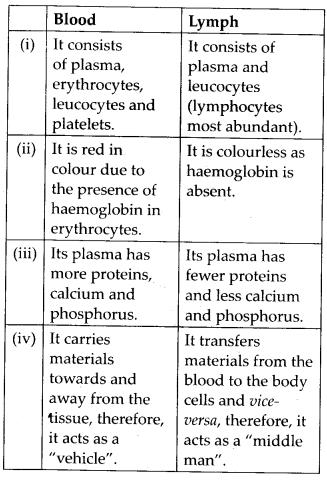
Solution: The type of blood circulation in which oxygenated blood and deoxygenated blood do not get mixed is termed double circulation. It includes systemic circulation and pulmonary circulation. The circulatory pathway of double circulation is given in the following flow chart.
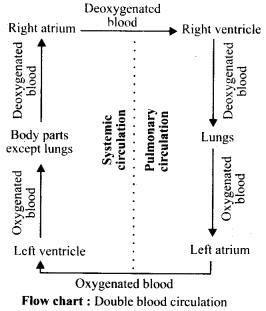
Write the differences between:
(a) Blood and lymph
(b) Open and closed system of circulation
(c) Systole and diastole
(d) P-wave and T-wave
Solution: (a) Refer answer 5.
(b) The differences between open and closed circulatory system are given below:
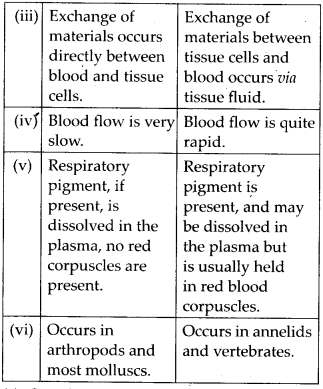
(c) Systole is contraction of heart chambers in order to pump out blood while diastole is relaxation of heart chambers to receive blood. The contraction of a chamber or systole decreases its volume and forces the blood out of it, whereas its relaxation or diastole brings it back to its original size to receive more blood.
(d) P wave is a small upward wave of elec-trocardiograph that indicates the atrial depolarisation (contraction of atria). It is caused by the activation of SA node. T-wave is a dome shaped wave of electro-cardiograph which represents ventricular repolarisation (ventricular relaxation).
Neural Control and Coordination
Class 11 Biology Excretory Products and their Elimination
Class 11 Biology Locomotion and Movement
1. Draw the diagram of a sarcomere of skeletal muscle showing different regions.
Solution: 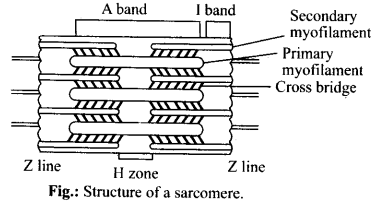
2. Define sliding filament theory of muscle contraction.
Solution: According to sliding filament theory of muscle contraction, the actin and myosin filaments slide past each other with the help of cross-bridges to reduce the length of the sarcomeres.
Solution: (a) Actin filaments and myosin filaments can be differentiated as follows: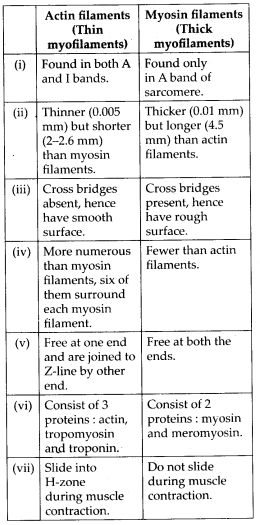
(b) Differences between red muscle fibres and white muscle fibres are given in the following table:
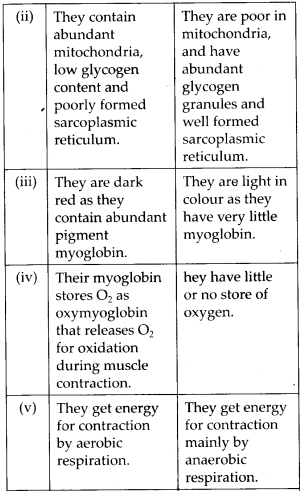
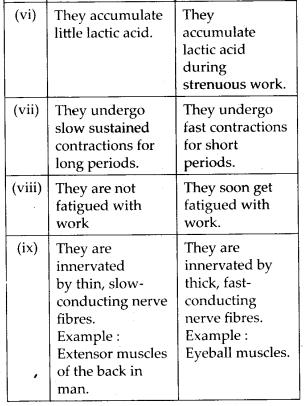
(c) Differences between pectoral and pelvic girdles are given in the following table: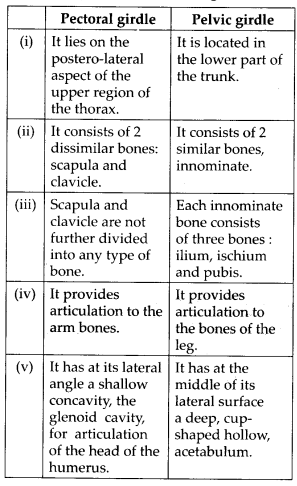
6. Match Column I with Column II:
Column I Column II
(a) Smooth muscle (i) Myoglobin
(b) Tropomyosin (ii) Thin filament
(c) Red muscle (iii) Sutures
(d) Skull (iv) Involuntary
Solution.(a) – (iv), (b)-(ii), (c)-(i), (d)-(iii)
CBSE Class 11 Biology
DIVERSITY IN THE LIVING WORLD
1 : The Living World
2 : Biological Classification
3 : Plant Kingdom
4 : Animal Kingdom
STRUCTURAL ORGANISATION IN PLANTS AND ANIMALS
5 : Morphology of Flowering Plants
6 : Anatomy of Flowering Plants
7 : Structural Organisation in Animals
PLANT PHYSIOLOGY
11 : Transport in Plants
12 : Mineral Nutrition
13 : Photosynthesis in Higher Plants
14 : Respiration in Plants
15 : Plant Growth and Development
1.What are the factors affecting the rate of diffusion?
.Differentiate between the following:
(a) Diffusion and Osmosis
(b) Transpiration and Evaporation
(c) Osmotic Pressure and Osmotic Potential
(d) Imbibition and Diffusion
(e) Apoplast and Symplast pathway of movement of water in plants
(f) Gutta’tion and Transpiration
Soln.
(a) Differences between diffusion and osmosis are as follows :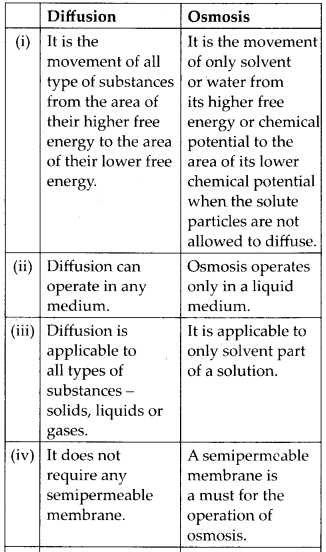
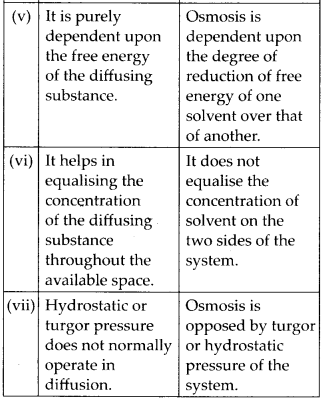
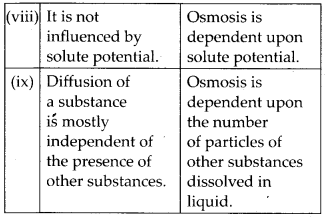
(b) Differences between transpiration and evaporation are as follows: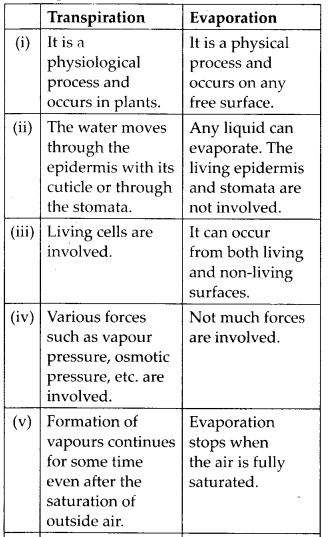
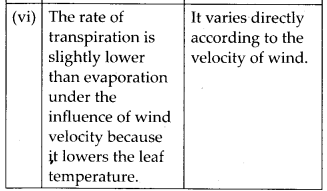
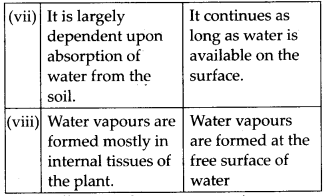
(c)Differences between osmotic pressure and osmotic potential are as follows: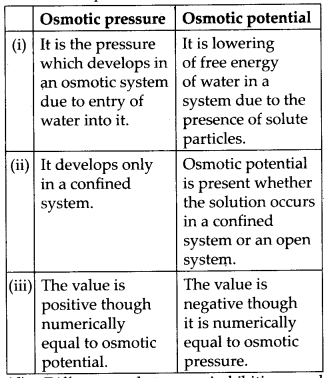
(d) Differences between imbibition and diffusion are as follows: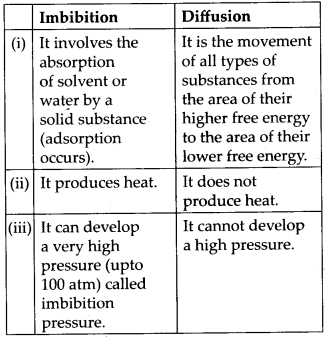
(e) Differences between apoplast pathway and symplast pathway are as follows: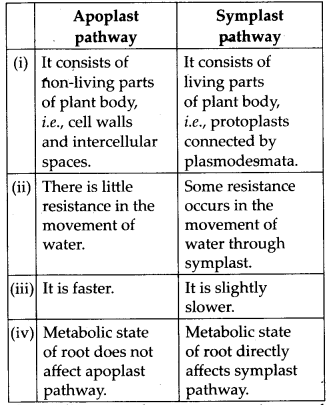
(f) Differences between guttation and transpiration are as follows: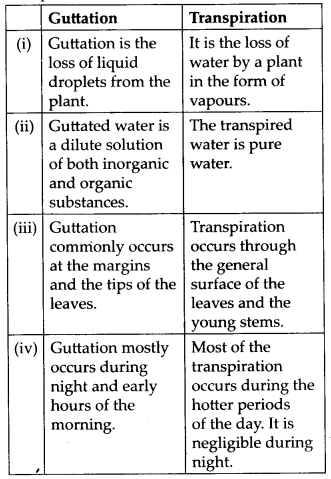
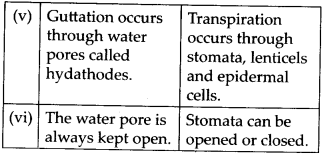
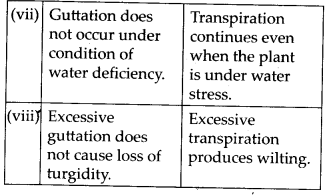
HUMAN PHYSIOLOGY
16 : Digestion and Absorption
17 : Breathing and Exchange of Gases
18 : Body Fluids and Circulation
19 : Excretory Products and their Elimination
20 : Locomotion and Movement
21 : Neural Control and Coordination
22 : Chemical Coordination and Integration
Human physiology
(a) Why are villi present in the intestine and not in the stomach?
(b) How does pepsinogen change into its active form?
(c) What are the basic layers of the wall of alimentary canal?
(d) How does bile help in the digestion of fats?
4. State the role of pancreatic juice in digestion of proteins.
5. Describe the process of digestion of protein in stomach.
6. Give the dental formula of human beings.
7. Bile juice contains no digestive enzymes, yet it is important for digestion. Why?
8. Describe the digestive role of chymotrypsin. What two other digestive enzymes of the same category are secreted by its source gland?
9. How are polysaccharides and disaccharides digested?
10. What would happen if HCl were not secreted in the stomach?
11. How does butter in your food gets digested and absorbed in the body?
12. Discuss the main steps in the digestion of proteins as the food passes through different parts of the alimentary canal.
13. Explain the term thecodont and diphyodont.
14. Name different types of teeth and their number in an adult human.
15. What are the functions of liver?
Cell: Strucutre and Functions
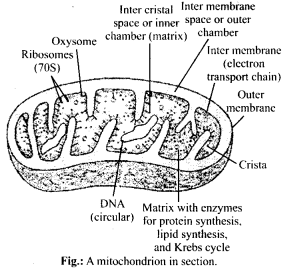
Functions of mitochondria:
:
- Mitochondria are essential for aerobic respiration.
- Mitochondria provide intermediates for synthesis of important biomolecules such as chlorophyll, cytochrome, steroids etc.
- Mitochondria regulate the calcium ion concentration in the cell.
- Mitochondrial matrix contains enzymes for the synthesis of fatty acids.
- Synthesis of many amino acids takes place here
Chloroplast: They are green coloured plastids which are disc shaped. The space limited by inner membrane of chloroplast is called as stroma. Stroma has organised flattened membranous sacs called the thylakoids. Thylakoids are arranged in stacks called grana. Matrix of a chloroplast contains DNA, RNA, ribosomes and enzymes. Chloroplast is also a semiautonomous organelle.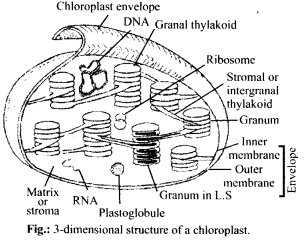
Functions of chloroplast:
- Photosynthesis is performed by chloroplast.
- Chloroplast stores starch grains.
- Maintains balance of C02 concentration in the air.
- Keeps oxygen balance constant in atmosphere by liberating 02 into the atmosphere, used during respiration and combustion.
8.What are the characteristics of prokaryotic cells?
Solution: Characteristics of prokaryotic cells are as follows:
- The prokaryotic cell is essentially a single – envelope system.
- Prokaryotes lack membrane bound cell organelles.
- Prokaryotes have 70S ribosomes.
- DNA is naked and lies coiled in cytoplasm. It is not covered by nuclear membrane and is termed as nucleoid.
- Nuclear components, like, nuclear envelope, nucleolus, nucleoplasm are absent.
- Cell wall is present in bacteria and cyanobacteria, but absent in mycoplasma.
- Multiplies by asexual reproduction.
- Transcription and translation takes place in cytoplasm.
9.Multicellular organisms have division of labour. Explain.
Soln. Division of labour is differentiation of certain components or parts to perform different functions for increased efficiency and higher survival. Multicellular organisms often possess millions of cells. Various cells are grouped together to form specific tissue, organ or organ system, with each specialised to perform particular function. Every cell of a multicellular organism cannot obtain food from outside. The organism requires a system for obtaining food, its digestion and distribution. Therefore, a digestive system and system of transport are also required. Certain cells of the body take over the function of reproduction. Others take part in repair and replacement of worn out or injured portions. For optimum functioning of cells, a multicellular organism also requires an internal favourable environment. Therefore, multicellular organisms come to have division of labour.
10.Cell is the basic unit of life. Discuss in brief.
Soln. Cell is fundamental, structural and functional unit of life, as no living organism can have life without being cellular. All life begins as a single cell. An organism is either made of single cell (unicellular) or many cells (multicellular). In unicellular organism, single cell is capable of independent existence and perform all essential functions of life, while in multicellular organism, each group of cells is specialised for specific function. Life passes from one generation to the next in form of cells, and new cell always arise from division of pre-existing cells. Cells are totipotent, i.e., single cell has ability to form whole organism. The activities of an organism are sum total of activities of its cells, therefore, cell is the basic unit of life.
11.What are nuclear pores? State their function.
Soln. Nuclear envelope bounds the nucleus from outside and separates it from cytoplasm. It consists of two membranes, with outer membrane continuous with endoplasmic reticulum. The nuclear envelope is interrupted by minute nuclear pores, at a number of places, which are produced by the fusion of its two membranes. These
nuclear pores are the passages through which movement of RNA and protein molecules takes place in both directions between the nucleus and the cytoplasm.
12.Both lysosomes and vacuoles are endomem-brane ‘structures, yet they differ in terms of their functions. Comment.
Soln. Organelles of endomembrane system such as lysosome and vacuoles function in close coordination with one another but are specialised to perform different functions. Lysosomes breakdown the ageing and dead cells, they help in digestion of food as they contain hydrolytic digestive enzymes. They are involved in cell division also. Vacuoles on other hand, help in excretion and osmoregulation in Amoeba (contractile vacuole) or provides buoyancy, mechanical strength in prokaryotes (air vacuoles).
13.Describe the structure of the following withthe help of labelled diagrams.
(i) Nucleus (ii) Centrosome
Soln.(i) Nucleus: Nucleus is double membrane bound principle cell organelle which contains all genetic information for controlling cellular metabolism and transmission of genetic information.
Nucleus is differentiated into following four parts:
(a) Nuclear envelope: It is a double membrane bound envelope that surround the nucleus and separates the latter from the cytoplasm.
(b) Nucleoplasm: Itis clear, non-staining, fluid material present in the nucleus, which contains raw materials (nucleotides), enzymes (DNA/RNA polymerases) and metal ions for the synthesis of RNAs and DNA. The nuclear matrix or the nucleoplasm is composed of nucleolus and chromatin.
(c) Nucleolus: It is a naked, round and slightly irregular structure, which is attached to the chromatin at a specific region. It is a site for active ribosomal RNA synthesis.
(d) Chromatin : It has the ability to get stained with certain basic dyes. It is known to be the hereditary DNA protein fibrillar complex. The chromatin fibres are distributed throughout the nucleoplasm.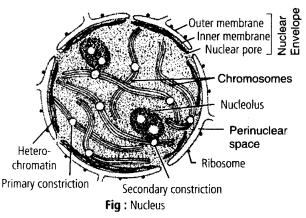
(ii) Centrosome: Centrosome is an organelle usually containing two cylindrical structures called centrioles. They are surrounded by amorphous pericentriolar materials. Both the centrioles in a centrosome lie perpendicular to each other. They are made up of nine evenly spaced peripheral fibrils of tubulin protein. Each of the peripheral fibril is a triplet. The adjacent triplets are also linked. The hub of centriole is connected with tubules of the peripheral triplets by radial spokes made of protein.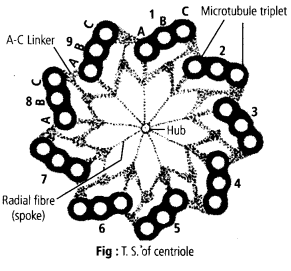
What is a centromere? How does the position of centromere form the basis of classification of chromosomes. Support your answer with a diagram showing the position of centromere on different types of chromosomes.
Soln. A chromosome consists of two identical halves, the chromatids held together at one point called the centromere. The centromere is also called as primary constriction. On its side a disc shaped structure called kinetochore is present. Chromosomes are classified into four types according to position of centromere on the chromosome.
(i) Metacentric chromosome: In this chromosome, centromere is in the middle and the two arms are almost equal in length.
(ii)Submetacentric chromosome: The centromere is slightly away from middle point so one arm is slightly shorter than the other.
(iii)Acrocentric chromosome: The centromere is near the end and one arm is extremely short and other arm is extremely long.
(iv)Telocentric chromosome: Centromere is at the tip of chromosome. These chromosomes are not present in humans.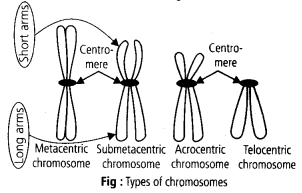
Class 11 Biology Cell Cycle and Cell Division
1. What is the average cell cycle span for a mammalian cell?
Solution: 24 hours.
2. Distinguish cytokinesis from karyokinesis.
Solution: Differences between cytokinesis and karyokinesis are: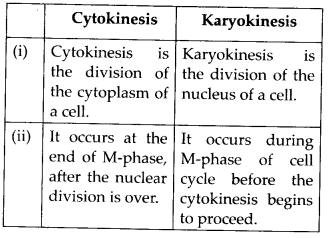
3. Describe the events taking place during the interphase.
Solution: The interphase, though called the resting phase, is metabolically quite active. It is the time during which the cell prepares itself for division by undergoing both cell growth and DNA replication in an orderly manner. The interphase is further divided into three phases:
• G1 (Gap 1) phase
• S (Synthesis) phase
• G2 (Gap 2) phase
G1 phase corresponds to the interval between mitosis of previous cell cycle and initiation of DNA replication. During G1 phase the cell is metabolically active and grows continuously but does not replicate its DNA S or synthesis phase marks the period during which DNA synthesis or replication takes place. During this time the amount of DNA doubles per cell. In animal cells, during the S phase, DNA replication occurs in the nucleus, and the centriole duplicates in the cytoplasm. During the G2 phase synthesis of DNA stops while cell growth continues with synthesis of protein and RNA in preparation for mitosis.
4. What is G0 (quiescent phase) of cell cycle?
Solution: G0 phase is the phase of inactivation of cell cycle due to non-availability of mitogens and energy rich compounds. Cells in this stage remain metabolically active but no longer proliferate i.e., do not grow or differentiate unless called on to do so depending on the requirement of the organism. E.g., Nerve and heart cells of chordates are in permanent G0 phase.
5. Why is mitosis called equational division?
Solution: Mitosis is a type of cell division in which chromosomes replicate and become equally distributed in two daughter nuclei so that the daughter cells come to have the same number and type of chromosomes as present in parent cell. So mitosis is called as equational division.
Describe the following:
(a) Synapsis
(b) Bivalent
(c) Chiasmata
Draw a diagram to illustrate your answer.
Solution:
(a) Synapsis: During zygotene of prophase I stage homologou s chromosomes start pairing together and this process of association is called synapsis. Electron micrographs of this stage indicate that chromosome synapsis is accompanied by the formation of complex structure called synaptonemal complex.
(b) Bivalent: The complex formed by a pair of synapsed homologous chromosomes is called a bivalent or a tetrad i.e., 4 chromatids or a pair of chromosomes.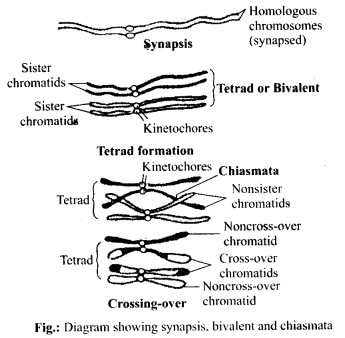
(c) Chiasmata: The beginning of diplotene is recognized by the dissolution of the synaptonemal complex and the tendency of the synapsed homologous chromosomes of the bivalents to separate from each other except at the sites of crossovers. These points of attachment (X-shaped structures) between the homologous chromosomes are called chiasmata.
List the main differences between mitosis and meiosis.
Solution:
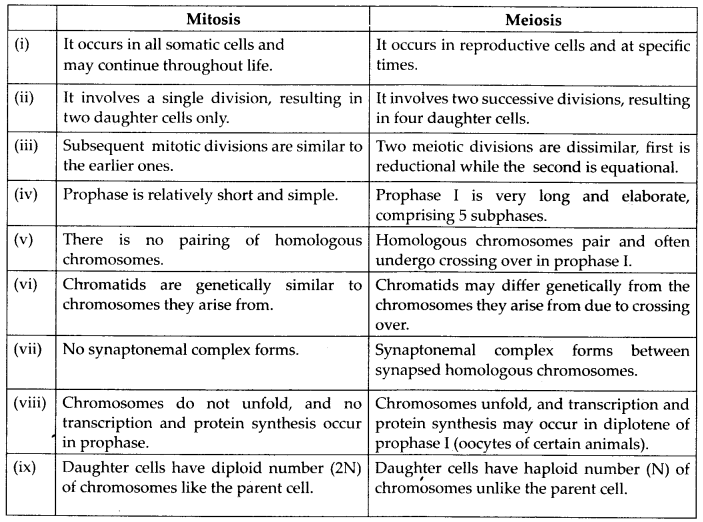
Class 11 Biology Structural Organisation in Animals
Class 11 Biology Chemical Coordination and Integration
1. Define the following:
(a) Exocrine gland,
(b) Endocrine gland,
(c) Hormone.
Solution:
(a) Exocrine gland is a gland that pours its secretion on the surface or into a particular region by means of ducts for performing a metabolic activity, e.g., sebaceous glands, sweat glands, salivary glands and intestinal glands.
(b) Endocrine gland is an isolated gland (separates even from epithelium forming it) which secretes informational molecules or hormones that are poured into venous blood or lymph for reaching the target organ because the gland is not connected with the target organ by any duct. Therefore endocrine gland is also called ductless gland e.g. thyroid gland.
(c) Hormone is a substance that is manu-factured and secreted in very small quantities into the blood stream by an endocrine gland or a specialized nerve cell and regulates the growth or functioning of a specific tissue organ in a distant part of the body e.g insulin.
2. Diagrammatically indicate the location of the various endocrine glands in our body.
Solution: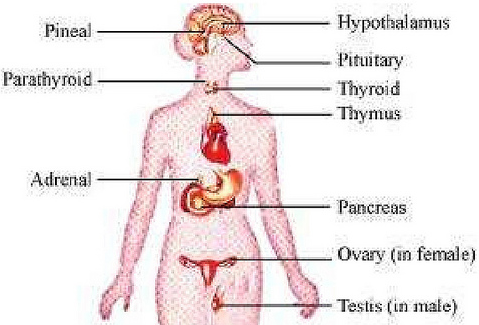
Write the differences between:
(a) Actin and Myosin
(b) Red and White muscles
(c) Pectoral and Pelvic girdle
3. List the hormones secreted by the following:
(a) Hypothalamus
(b) Pituitary
(c) Thyroid
(d) Parathyroid
(e) Adrenal
(f) Pancreas
(g) Testis
(h) Ovary
(i) Thymus
(j) Atrium
(k) Kidney
(l) G-l Tract.
Solution:
(a) Two types of hormones are produced by hypothalamus : releasing hormones (that stimulate secretion of pituitary hormones) and inhibiting hormones (that inhibit secretion of pituitary hormones).
These hormones are:
Thyrotrophin-releasing hormone Adreno-
corticotrophin-releasing hormone
Follicle-stimulating hormone-releasing hormone
Luteinizing hormone-releasing hormone
Growth hormone-releasing hormone
Growth inhibiting hormone
Prolactin releasing hormone
Prolactin inhibiting hormone
Melanocyte stimulating hormone¬releasing hormone
Melanocyte stimulating hormone- inhibiting hormone.
(b) Different parts of pituitary secrete different hormones.
Hormones secreted by anterior lobe of pituitary are:
Follicle stimulating hormone
Luteinizing hormone
Thyroid stimulating hormone
Adrenocorticotrophic hormone
Somatotrophic or Growth hormone
Prolactin hormone or Luteotrophic hormone.
Middle (intermediate) lobe of pituitary : Melanocyte stimulating hormone.
Posterior lobe of pituitary:
(i) Oxytocin
(ii) Vasopressin or antidiuretic hormone.
(c) Thyroid secretes 3 hormones:
Thyroxine or tetraiodothyronine
Triiodothyronine
Calcitonin.
(d) Parathyroid gland secretes a single hormone called parathormone (PTH) or Collip’s hormone.
(e) Adrenal glands have two regions, namely, outer adrenal cortex and inner adrenal medulla. Both these regions secrete different hormones.
Hormones of adrenal cortex are grouped into three categories:
Glucocorticoids, e.g., cortisol
Mineralocorticoids, e.g., aldosterone
Sexcorticoids e.g testosterone. Adrenal medulla secretes two hormones
(i) Epinephrine (adrenaline)
(ii)Nor-epinephrine (nor-adrenaline).
(f) Pancreas secretes following hormones:
Insulin
Glucagon
Somatostatin.
(g) Testis secretes androgens such as testosterone.
(h) Ovary secretes:
Estrogens such as estradiol
Progesterone
Relaxin.
(i) Thymus secretes thymosin hormone.
(j) Atrium secretes atrial natriuretic factor (ANF).
(k) Kidney secretes:
(i) Renin (ii) Erythropoetin
(l) G.I. tract secretes :
Gastrin
Secretin
Cholecystokinin
Enterocrinin
Duocrinin
Villikinin.
4. Fill in the blanks:
Hormones Target gland
(a) Hypothalamic hormones ………………..
(b) Thyrotrophin (TSH) ………………..
(c) Corticotrophin (ACH) ………………..
(d) Gonadotrophins (LH, FSH) ………………..
(e) Melanotrophin (MSH) ………………..
Solution:
(a) Pituitary
(b) Thyroid
(c) Adrenal cortex
(d) Gonads -Testes in male and ovaries in female
(e) Skin.
5. Write short notes on the functions of the following hormones:
(a) Parathyroid hormones (PTH)
(b) Thyroid hormones
(c) Thymosin
(d) Androgens
(e) Estrogens
(f) Insulin and Glucagon.
Solution:
(a) Parathyroid hormone increases the level of calcium and decreases the level of phosphate in the blood.
(b) Thyroid gland secretes three hormones: thyroxine, triiodothyronin and calcitonin. Thyroxine and triiodothyronin control the general metabolism of the body, promote growth of body tissues and stimulates tissue differentiation. Calcitonin regulates the concentration of calcium in the blood.
(c) Thymosin is secreted by thymus. It accelerates cell division, stimulates the development and differentiation of T-lymphocytes and also hastens attainment of sexual maturity.
(d) Androgens are secreted by testis. They stimulate the development of male reproductive system, formation of sperms, development of male accessory sex characters and also determines the male sexual behaviour and the sex urge.
(e) Estrogens are secreted by ovaries. They stimulate the female reproductive tract to grow to full size and become functional, differentiation of ova and development of accessory sex characters.
(f) Insulin is secreted by the |3-cells of the pancreas. It lowers blood glucose level, and promotes synthesis of proteins and fats. Glucagon is secreted by the a-cells of the pancreas. It increases the level of glucose in the blood.
6. Give example(s) of
(a) Hyperglycemic hormone and hypoglyce-mic hormone
(b) Hypercalcemic hormone
(c) Gonadotrophic hormones
(d) Progestational hormone
(e) Blood pressure lowering hormone
(f) Androgens and estrogens.
Solution:
(a)Glucagon, Insulin
(b) Parathormone (PTH)
(c) Follicle stimulating hormone (FSH) and Luteinizing hormone (LH)
(d) Progesterone
(e) Atrial natriuretic factor
(f) Testosterone and Estradiol.
7. Which hormonal deficiency is responsible for the following:
(a) Diabetes meilitus
(b) Goitre
(c) Cretinism.
Solution:
(a) Insulin
(b) Thyroxine and Triiodothyronine
(c) Thyroxine and Triiodothyronine.
8. Briefly mention the mechanism of action of FSH.
Solution: (Folliclestimulatinghormone)being glycoprotein is insoluble in lipids, therefore,
cannot enter the target cells. It binds to the specific receptor molecules located on the surface of the cell membrane to form hormone – receptor complex. This complex causes the release of an enzyme adenylate cyclase from the receptor site. This enzyme forms the cell cyclic adenosine monophosphate (cAMP) from ATP. The cAMP activates the existing enzyme system of the cell. This accelerates the metabolic reactions in the cell. The hormone is called the first messenger and the cAMP is termed the second messenger. The hormone- receptor complex changes the permeability of the cell membrane to facilitate the passage of materials through it. This increases the activities of the cell as it receives the desired materials.
9. Match the following :
Column I Column II
(a) T4 (i) Hypothalamus
(b) PTH (ii)Thyroid
(c) GnRH (iii)Pituitary
(d) LH (iv) Parathyroid.
Solution:
(a) – (ii); (b) – (iv); (c) – (i); (d) – (iii)
CLASS 12 TBSE CBSE NEET JEE ADMISSION 2024
CLASS STARTS 1st April 2023
Learn with Gold Medalist, Doctorate, NITian, Asst Professor, AIR-1, Toppers Exp. Guide
What We Guide: School Of Learning Coaching
TBSE CBSE ICSE Board from Class VI-XII, College, University Students (Arts, Science and Commerce), Drawing, Music also available here.
We also guide Common University Entrance Test (CUET)- All India Level Entrance for the admission in Colleges and Universities.
*BA BSC LLB BBA BA-BEd BSC-BEd, IMD
Medical (NEET) and Engineering(JEE) Entrance,TPSC-Civil Services, Competitive Exams guidance also done by the experts.
Guidance for Teaching Job: Tripura TET & CTET, UGC NET/SLET
Competitive Govt Job Coaching
Vocational Training Course
- Medical & Engineering Entrance
Board + NEET + TBJEE
JEE (Main & Advanced)
- CUET (Common University Entrance Test)
Degree College Entrance
Eligibility: Class 12 Final Students
Master Degree Entrance
Eligibility: Degree 5-6th Semester Final Students
- College Tuition
B.A B.Sc B.Com (Pass & Honours) all subjects
- University Tuition
M.A. M.SC, M.COM
- TPSC-COMPETITIVE EXAMS
- COMPETITIVE EXAMS



